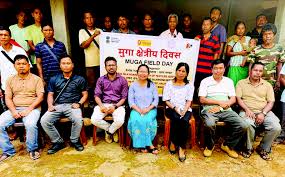
Williamnagar Hosts One-Day Muga Field Day to Boost Sustainable Silk Farming

 :
| Updated On: 12-Aug-2025 @ 12:51 pm
:
| Updated On: 12-Aug-2025 @ 12:51 pmSHARE
The Central Silk Board’s Sub-Station for Pilot Cultivation (SSPC) at Kaliabari, Boko, in collaboration with the District Sericulture Office, organised a one-day Muga Field Day on Monday at the muga farms of Williamnagar in East Garo Hills, Meghalaya. The programme aimed to strengthen the region’s traditional silk culture while promoting sustainable livelihoods for rural communities engaged in muga silkworm rearing.
The event was chaired by Shri Dharavath Saicharan, Scientist-B and In-charge of SSPC Kaliabari, who highlighted the long-term income potential of muga culture for local farmers. He stressed that muga silk, unique to Northeast India, especially Assam and parts of Meghalaya, has both cultural heritage value and significant economic potential. By adopting improved scientific rearing practices, farmers could achieve better productivity and quality, leading to higher market returns.
Smt. S. G. Momin, District Sericulture Officer of East Garo Hills, along with Shri Charnenko Sangma, Sericulture Demonstrator, addressed the gathering, urging farmers to embrace modernised and efficient rearing techniques. They emphasised that while traditional methods have sustained the silk industry for generations, integrating scientific approaches can help overcome challenges such as disease outbreaks, pest infestations, and low yield.
The Muga Field Day included technical demonstration sessions focusing on:
-
Host plant management – Ensuring proper cultivation, pruning, and maintenance of primary muga host plants like Som and Sualu to support healthy silkworm feeding.
-
Pest and disease prevention – Educating farmers on identifying early signs of common threats, adopting eco-friendly control measures, and implementing hygiene practices in rearing houses.
-
Scientific grainage techniques – Training participants on seed production, handling, and preservation methods to ensure quality silkworm eggs for future cycles.
During the programme, farmers were introduced to the Mera Resham Mera Abhiman initiative, a national campaign celebrating India’s rich silk heritage. The initiative seeks to inspire farmers to expand muga cultivation, enhance its visibility in markets, and preserve its cultural identity while strengthening rural economies.
A field visit was organised as a core part of the day’s activities, showcasing live examples of best practices in muga silkworm rearing. Experienced sericulture workers demonstrated step-by-step techniques, from host plant preparation to cocoon harvesting. Farmers from various villages across East Garo Hills actively participated, sharing their personal experiences, challenges, and successes in muga farming. Many expressed keen interest in adopting muga culture as an additional or alternative livelihood source, recognising its resilience and profitability compared to other agricultural activities.
The event concluded with an interactive session where farmers had the opportunity to directly engage with experts. Discussions covered practical solutions to common challenges faced in muga production, such as climate fluctuations, lack of quality seed supply, and limited access to advanced rearing facilities. The session also explored market linkages for muga cocoons and yarn, including ways to connect with buyers, traders, and silk processing units to ensure better prices and reduced exploitation by middlemen.
Through its blend of technical training, awareness generation, and hands-on demonstration, the Muga Field Day at Williamnagar successfully reinforced the potential of muga sericulture as a sustainable livelihood option and an integral part of Meghalaya’s cultural and economic fabric.